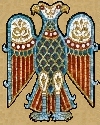 Byzantine Paganism
Byzantine Paganism

 Byzantine Paganism
Byzantine Paganism

History
Click on a title below to visit a section of the Byzantine Pagan site:
![]()
Home
~
History ~
Heroes
~
Rituals ~
Priesthood
Documents ~
News
~
Forum ~
Shop ~
Links
~
FAQ
![]()
|
There is no one set date which
marks the passing of Classical Paganism and the beginning of Byzantine Paganism.
The vision of the Emperor Constantine at the Milvian Bridge in 311 AD can be
thought of as the start of the process, and the Edict of Milan in 313 AD as its
first official step.
Traditionally, the history of Paganism in the Byzantine Empire has been presented through little more than lists of official edicts and persecutions detailing the "end" of ancient religion. More detailed research shows that this process happened much more slowly than is usually presented - and that in fact Paganism never completely died in the Byzantine world. The history of Classical Religion in the Christian Eastern Roman Empire is not a happy history, but it is a surprising one. It is a story of faith and reason continuing to exist under overwhelming odds. Most of it remained unwritten - but enough facts have survived to show proof. Through Byzantium, the Classical faiths just barely managed to bridge the gap from the ancient world to the modern world. There were still those faithful to the Gods who fled to the West after the destruction of Constantinople, helping to bring ancient Classical writings and sciences which laid the foundations of the Renaissance.
|
© Copyright Byzantium Novum, 2024